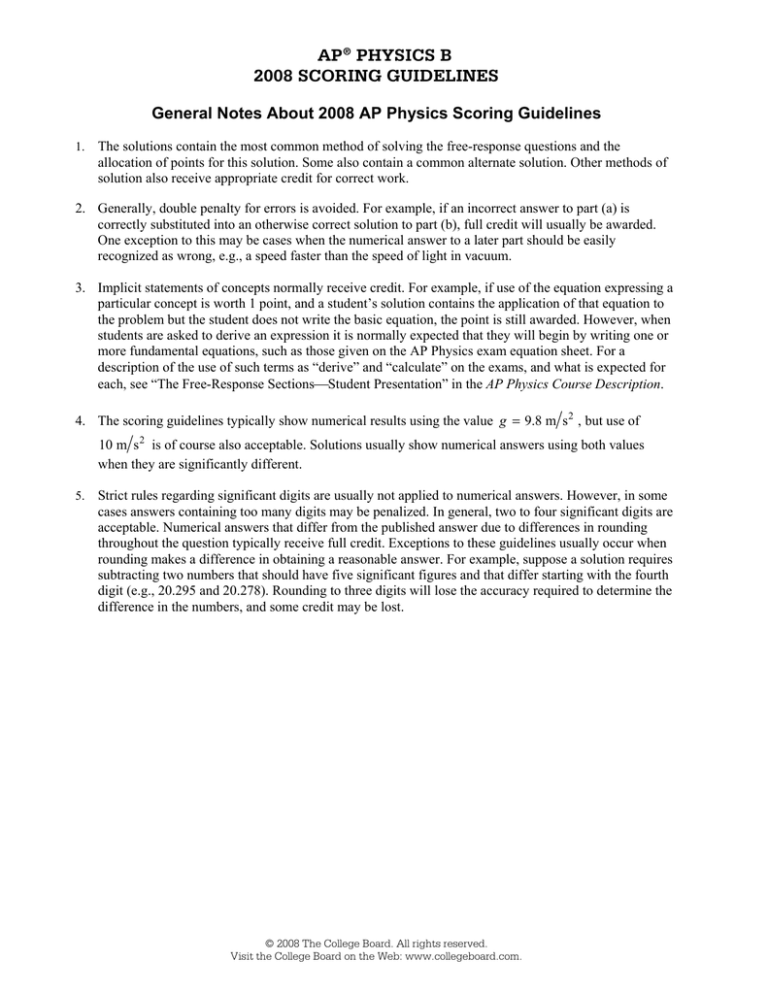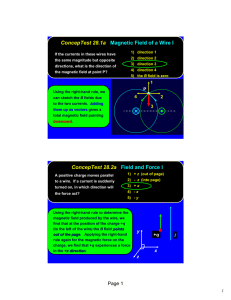
AP® PHYSICS B
2008 SCORING GUIDELINES
General Notes About 2008 AP Physics Scoring Guidelines
1.
The solutions contain the most common method of solving the free-response questions and the
allocation of points for this solution. Some also contain a common alternate solution. Other methods of
solution also receive appropriate credit for correct work.
2. Generally, double penalty for errors is avoided. For example, if an incorrect answer to part (a) is
correctly substituted into an otherwise correct solution to part (b), full credit will usually be awarded.
One exception to this may be cases when the numerical answer to a later part should be easily
recognized as wrong, e.g., a speed faster than the speed of light in vacuum.
3. Implicit statements of concepts normally receive credit. For example, if use of the equation expressing a
particular concept is worth 1 point, and a student’s solution contains the application of that equation to
the problem but the student does not write the basic equation, the point is still awarded. However, when
students are asked to derive an expression it is normally expected that they will begin by writing one or
more fundamental equations, such as those given on the AP Physics exam equation sheet. For a
description of the use of such terms as “derive” and “calculate” on the exams, and what is expected for
each, see “The Free-Response Sections⎯Student Presentation” in the AP Physics Course Description.
4. The scoring guidelines typically show numerical results using the value g = 9.8 m s2 , but use of
10 m s 2 is of course also acceptable. Solutions usually show numerical answers using both values
when they are significantly different.
5.
Strict rules regarding significant digits are usually not applied to numerical answers. However, in some
cases answers containing too many digits may be penalized. In general, two to four significant digits are
acceptable. Numerical answers that differ from the published answer due to differences in rounding
throughout the question typically receive full credit. Exceptions to these guidelines usually occur when
rounding makes a difference in obtaining a reasonable answer. For example, suppose a solution requires
subtracting two numbers that should have five significant figures and that differ starting with the fourth
digit (e.g., 20.295 and 20.278). Rounding to three digits will lose the accuracy required to determine the
difference in the numbers, and some credit may be lost.
© 2008 The College Board. All rights reserved.
Visit the College Board on the Web: www.collegeboard.com.
AP® PHYSICS B
2008 SCORING GUIDELINES
Question 3
15 points total
(a)
Distribution
of points
4 points
For using Ohm’s law to find the total resistance of the circuit
e I = Rtotal
16 V 4.0 A = 4.0 Ω
For a correct expression for the total resistance that has the internal resistance of the
power supply in series with the wire’s resistance
Rinternal + Rwire = Rtotal
1 point
1 point
0.50 W + Rwire = 4.0 W
Rwire = 3.5 W
An alternate solution is to use a circuit equation to determine the voltage across the
wire for the first point, and then Ohm’s law to determine its resistance for the
second point.
Vwire = Vterm = e - Vint = 16 V - (4.0 A )(0.50 W ) = 14 V
Rwire = V I = 14 V 4.0 A = 3.5 W
Using the expression for the resistance of a wire in terms of its dimensions
Rwire = rL A
L = Rwire A r
For correct substitutions
(
L = (3.5 W) 3.5 ¥ 10
-9
m
2
) (1.7 ¥ 10
-8
Wim
)
For a correct answer with correct units
L = 0.72 m
Note: The last 2 points could be earned for showing understanding of R = rL A by
using it with the appropriate values of r and A and some value of resistance.
(b)
1 point
1 point
4 points
The force on the magnet is upwards.
Points are awarded for the justification as follows.
For indicating that the right-hand rule should be used
For correctly identifying the direction of the magnetic field between the poles of the
magnet as being to the right
For obtaining a downward force on the wire using the right-hand rule
Example for the above 3 points: The direction of the force on the wire is given by the
right-hand rule. The current is into the page and the magnetic field is to the right. By
the right-hand rule, the force on the wire is then downwards.
For using Newton’s 3rd Law
For example: The force on the wire is downwards, so the force on the magnet must be
upwards.
Note: A student who checks “downward” can receive 3 of 4 points if they correctly use
the right-hand rule to show that the force on the wire is downward. Just checking
the box “upward” without justification received no points.
© 2008 The College Board. All rights reserved.
Visit the College Board on the Web: www.collegeboard.com.
1 point
1 point
1 point
1 point
AP® PHYSICS B
2008 SCORING GUIDELINES
Question 3 (continued)
Distribution
of points
(c)
3 points
For simplifying the formula given in the equation table for the force on a currentcarrying wire (or stating that q = 90∞ )
F = ILB
For correct substitutions
(0.060 N )
F
B=
=
IL
( 4.0 A )(0.020 m )
For a correct answer with correct units
B = 0.75 T
(d)
1 point
1 point
3 points
For a straight-line relationship
For a relationship that passes through the origin
For a slope less than the original line but NOT zero
(e)
1 point
1 point
1 point
1 point
1 point
For a plausible source of error that would produce the plotted results
For example: The horizontal width of the wire approaches the width of the magnet.
Near the edges of the magnet the strength of the magnetic field decreases. As the
length of the wire increases, the magnetic field experienced by the ends of the wire
decreases in strength, leading to a smaller magnetic force than expected.
© 2008 The College Board. All rights reserved.
Visit the College Board on the Web: www.collegeboard.com.
1 point
©2008 The College Board. All rights reserved.
Visit the College Board on the Web: www.collegeboard.com.
©2008 The College Board. All rights reserved.
Visit the College Board on the Web: www.collegeboard.com.
©2008 The College Board. All rights reserved.
Visit the College Board on the Web: www.collegeboard.com.
©2008 The College Board. All rights reserved.
Visit the College Board on the Web: www.collegeboard.com.
©2008 The College Board. All rights reserved.
Visit the College Board on the Web: www.collegeboard.com.
©2008 The College Board. All rights reserved.
Visit the College Board on the Web: www.collegeboard.com.
AP® PHYSICS B
2008 SCORING COMMENTARY
Question 3
Overview
Part (a) assessed student understanding of the relationships among resistance, resistivity, length, and area
for a wire, in the context of a wire connected across a power supply. Concepts of series resistance and
Ohm’s law were also needed to answer the question. Part (b) assessed understanding of the force on a
current-carrying wire in a magnetic field and the corresponding reaction force on the magnet.
Understanding of magnetic field directions, application of an appropriate hand rule, and Newton’s third
law were needed to answer the question. Part (c) assessed application of the equation F = BI A sin q . Part
(d) assessed students’ ability to explain how a change in the orientation of the wire loop would affect the
experiment results. For part (e) students had to interpret experimental results and provide a rationale for
experimental error.
Sample: B3A
Score: 15
Full credit was awarded for every part of the problem. Note that reference is made to the left-hand rule in
the justification of part (b); this technique, sometimes referred to as Fleming’s left-hand rule, is sometimes
taught as an alternative to the right-hand rule and is entirely equivalent when used properly. The reason
provided in part (e) is essentially the same as the example in the scoring guidelines.
Sample: B3B
Score: 11
The calculation in part (a) is correct, and full credit was awarded. While the right-hand rule is mentioned in
part (b), earning 1 point, there is no mention of how it was used in the problem, so no additional points were
given. Parts (c) and (d) are correct, and full credit was awarded for each. The reason provided in part (e) is not
plausible, so no credit was given.
Sample: B3C
Score: 5
The internal resistance of the power supply is incorrectly used as the wire resistance, so 2 points were
deducted for failure to use Ohm’s law to determine the wire resistance. Two points were awarded in part (a),
however, as understanding of the relationship between resistivity and resistance was shown, using
appropriate values of resistivity and the cross-sectional area of the wire. No points were awarded for part (b),
as the incorrect choice is made, and the justification is invalid. No points were awarded for part (c), since the
incorrect angle is used, there is a substitution error for the length, and no units are given. Full credit was
earned for part (d). The reason provided in part (e) is not plausible, so no credit was given.
© 2008 The College Board. All rights reserved.
Visit the College Board on the Web: www.collegeboard.com.





